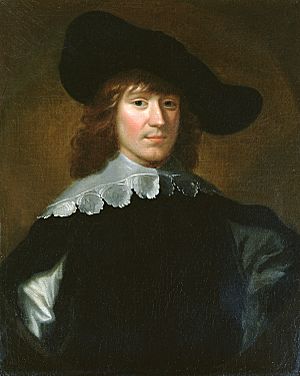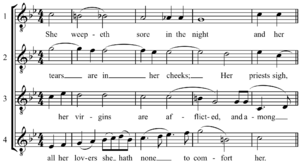William Lawes facts for kids
Quick facts for kids
William Lawes
|
|
|---|---|
 |
|
| Born | April 1602 |
| Died | 24 September 1645 (aged 43) Rowton Heath, Cheshire, England
|
William Lawes (born April 1602 – died 24 September 1645) was a famous English composer and musician. He lived during a time when England was going through big changes, including a civil war.
Contents
Life and Career
William Lawes was born in Salisbury, England, and was baptized on May 1, 1602. His father, Thomas Lawes, was a church musician at Salisbury Cathedral. William also had an older brother, Henry Lawes, who became a very successful composer too. William might have sung in the cathedral choir when he was young.
A powerful person named Edward Seymour, Earl of Hertford, helped William learn music. He arranged for William to study with a composer named John Coprario. This likely helped Lawes meet Charles, Prince of Wales, who later became King Charles I.
Both William and his brother Henry got jobs working for King Charles I. William became a "musician in ordinary" in 1635. This meant he was a regular musician for the King, playing instruments like the lute and singing. He had already been writing music for the royal court before this.
Lawes worked for King Charles I his whole adult life. He wrote many different kinds of music. This included songs and music for court shows called masques. He also wrote religious songs for the King's private worship.
Today, he is best known for his amazing music for viol instruments. These are like early versions of violins and cellos. His music for groups of viols, called "consort suites," was very special. He also wrote music for the lyra viol, a type of viol played by one person. His music was sometimes unusual and exciting, mixing strange sounds with calm ones. For a long time, people didn't play his music much, but now it is becoming popular again.
When the King and Parliament started fighting, leading to the English Civil War, Lawes joined the King's army. He was given a job in the King's Life Guards to keep him safe. However, he was sadly killed by a Parliamentarian soldier during a battle near Chester on September 24, 1645.
King Charles I was very sad about Lawes's death. He honored Lawes with the special title "Father of Musick." Lawes's body was never found, and his burial place is unknown.
Musical Style
William Lawes's music for instruments shows the style of the 1600s in England. He used strong rhythms and sounds that clashed a bit, which were different from older composers. His music was often experimental and showed off how skilled he was as a player. He was known to be a very talented player of the lyra viol.
His music for groups of instruments, especially his dance music, was very popular. These pieces were often grouped into collections called "consort sets." Ten of these sets make up a famous collection called the Royal Consort. He finished this collection in 1635 for King Charles I. It was written for different combinations of viols and other instruments.
Works
William Lawes wrote many pieces of music. Here are some examples of his works:
For Voice
- Dainty Fine Aniseed Water Fine, around 1630
- Drink Tonight of the Moonshine Bright, around 1630
- Gather Your Rosebuds While You May, around 1630
- She Weepeth Sore In the Night, around 1630
For Solo Instrument
- Music for Solo Lyra-Viol, around 1630
For Instrumental Ensemble
- Almain for 2 Lutes, around 1625
- Eight Sonatas (Fantasy Suites) for Violin, Bass Viol and Organ, around 1630
- Eight Sonatas (Fantasy Suites) for 2 Violins, Bass Viol and Organ, around 1630
- Royal Consort Sets (1-10) for 4 Viols and Continuo, 1635
For the Church
- 30 settings of Psalms for three voices
For the Stage
- Music for various court masques (special plays with music and dancing)
- Ye Fiends and Furies for a masque called The Unfortunate Lovers
See also
- Drexel 4041


